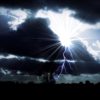Delicate Sound of Thunder: Exploring Electromagnetic Whistlers
When we think of lightning storms, we usually associate them with scary, booming claps of thunder. These audible bursts are caused by a sonic shockwave as lightning discharges. However, thunder is not the only sound of the storm. High above the clouds, in the farthest reaches of our atmosphere, another symphony is taking place. This is the concert hall of the electromagnetic electron wave, also known as a whistler.
What’s a Whistler?
Named for their resemblance to whistling, whistlers are very short, high-pitched sounds generated during storms. They exist exclusively in the ionosphere—collectively the farthest reaches of our atmosphere. As its name suggests, this layer is more heavily populated with ions, or charged atomic particles, than closer to Earth’s surface. Part of the reason ions gather farther from Earth is because the outer layers are closer to the magnetic field, which attracts ions like a, well, magnet.
Due to a higher density of ions, electromagnetism is more powerful. When lightning strikes, its electromagnetic particles use ions like conductors, coursing through them at rapid speeds. Just as thunder is a byproduct of lightning, whistlers are created by this movement through ions. Whistlers only exist in the ionosphere because of the concentrated charged particles. A whistler’s magnetic properties allow them to move through the ions like air through a horn.
Think of it this way: quality musical instruments are usually made with dense wood. The denser the wood, the more sound reverberates. This leads to louder and more stable sounds. It’s the same for whistlers.
What does a Whistler Sound Like?
As its name suggests, they are extremely high-pitched. A whistler’s frequency can range from 300 Hz (a little higher than middle C on a piano) to 30,000 Hz (just above what humans can hear). To put that in perspective, a cymbal crash clocks in around 8,000 Hz. This all means that whistlers are mostly audible to the human ear. However, the average lifespan of a whistler is about half a second, We’re only able to hear them at all because they happen in such rapid succession. You can listen to some here.
While whistlers are pretty cool unto themselves, they can also teach us a lot about the atmosphere as well as the magnetic field. Depending on their frequency and strength, researchers can gain an understanding about the amount of ions at various heights in the atmosphere which can then help determine the strength of the magnetic field.
So the next time you hear a thunderstorm, remember there’s a lot more happening high above the clouds—the sounds of our magnetic field hard at work.
Make sure to read about more magnetic magnetic facts on the rest of our blog!

